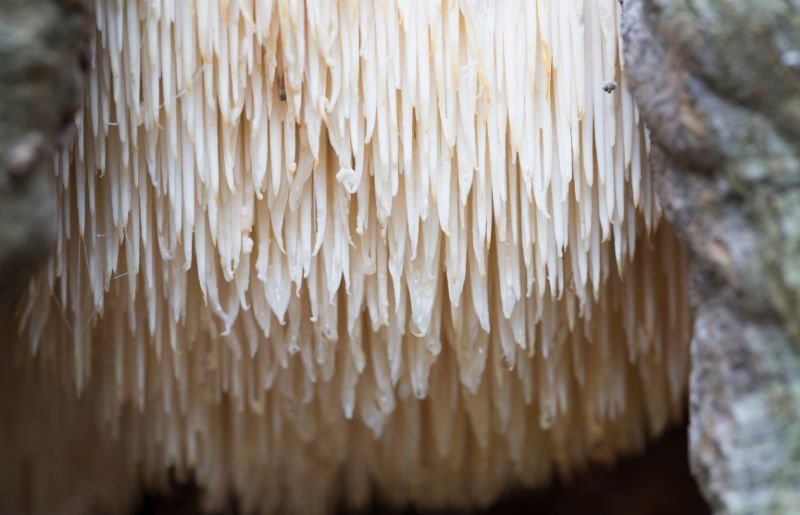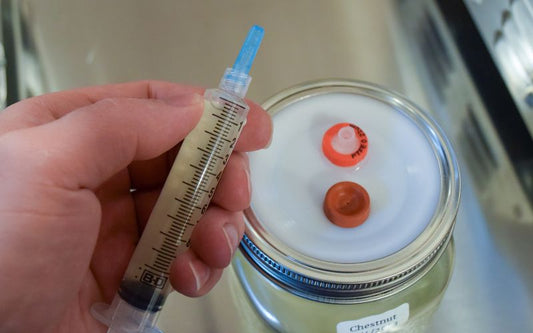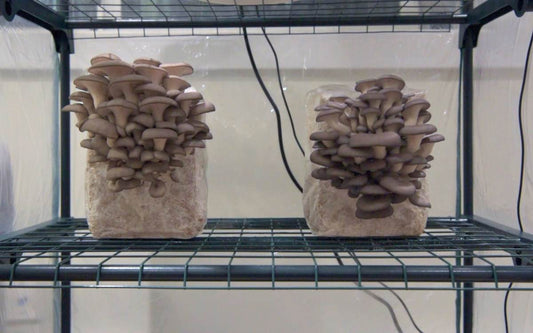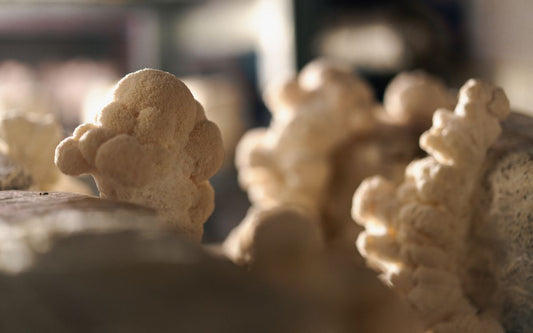If you're looking for a tasty and medicinal mushroom, look no further than lion's mane.
This unique mushroom has a long history of use in Asia and is now gaining popularity in the West.
In this guide, we'll provide everything you need to know about lion's mane mushrooms, from their medicinal benefits to growing lion's mane yourself.
What is lion's mane?
Lion's mane (Hericium erinaceus) is a member of the tooth fungus group.
The mushroom gets its name from its lion-like appearance, with long, shaggy spines that resemble a lion's mane.
It has a long history of medicinal and culinary use, which we'll cover later on.
Lion's mane mushrooms are native to North America, Europe, and Asia, and can be found growing on hardwood trees.
The mushroom typically fruits in the late summer and fall.

Can you eat lion's mane mushrooms?
Lion's mane mushrooms are not only edible but also quite delicious!
The taste has been described as a cross between seafood and chicken, making it a versatile ingredient for many recipes.
Many use it as a seafood substitute.
At Folk Fungi, we like to cut lion's mane into slices and pan-fry them in butter, garlic, and soy sauce.
Nutritional profile of lion's mane
In addition to their great taste, lion's mane mushrooms are packed with nutrients, making them a healthy choice.
Here is the nutritional profile of a 100 g serving of lion's mane:
- 35 calories
- 0 g fat
- 0 mg cholesterol
- 2 g fibre
- 2 g protein
- 2 g carbohydrates
- 300 mg potassium
- 10 mg sodium
- 2 mg calcium
Remember: fresh lion's mane is made up of over 80 percent water, which means about 10 g of dried mushrooms will provide the same nutritional value.
Should I cook lion's mane?
Like with most mushrooms, you should cook lion's mane before eating it.
Mushrooms contain chitin, found in the exoskeletons of shellfish, which is hard for humans to digest.
Cooking the mushroom will break down the chitin and make it easier to eat.

What are the medicinal benefits of lion's mane?
Lion's mane has long been used in Asia for its medicinal properties.
Today, Western science is beginning to grasp the power of lion's mane, especially its brain-boosting effects.
Below, you'll find some of the most common and promising medicinal uses.
Cognitive function and memory
The most well-known benefit of lion's mane is its ability to improve cognitive function and memory.
Some people use lion's mane as a coffee alternative because of the jitter-free focus it provides.
Inflammation
Lion's mane is also used to reduce inflammation.
The mushroom reduces the production of cytokines, which are proteins that contribute to inflammation.

Anxiety and depression
Lion's mane mushrooms may also help with anxiety and depression.
The mice that consumed lion's mane also had blood markers that indicated lower depression.
The study suggests that these effects are the result of the mushroom's anti-inflammatory properties.
Anti-cancer properties
And as if lion's mane couldn't get any better, the mushroom is also being studied for its anti-cancer properties.
In test-tube studies, compounds in lion's mane have been shown to kill cancer cells.
What's the best form of lion's mane to take?
Lion's mane comes in a few different forms, such as capsules and powders, tinctures, and, of course, the mushroom itself.
Below, we'll cover the benefits of each.
Capsules and powders
If you want to take lion's mane for cognitive benefits, capsules and powders are a good option.
They tend to be more concentrated than other forms and can provide a higher dose of compounds like hericystin and erinacines.
Plus, capsules and powders might be the easiest way to get your hands on lion's mane, as the mushroom is rarely sold in grocery stores.

Tinctures
Tinctures are another popular way to take lion's mane.
They're made by soaking the mushrooms in alcohol, which extracts its medicinal compounds.
People in recovery from alcohol addiction may wish to avoid tinctures because of the alcohol content.

Fresh mushrooms
Of course, you can also eat fresh lion's mane mushrooms.
Lion's mane is best cooked slowly over medium heat.
This allows the mushroom to retain its nutrients and prevents it from becoming tough.
Though, they aren't as easy to find as button or even oyster mushrooms.
You might get lucky at a farmer's market or a local Asian market.
Or you can grow your own, which we'll discuss later on.

Fruiting body versus mycelium
When you're looking to buy lion's mane supplements, you might see products that contain either the fruiting body or mycelium of the mushroom.
So what's the difference?
The fruiting body is the part of the mushroom that you can see, like the stem and cap (or, in the case of lion's mane, the white clump of spines).
This is what most people think of when they picture a mushroom.
The mycelium is the underground network of root-like structures that make up the main body of the fungi.

Mycelium is cheaper and quicker grow than the fruiting body, but it contains a lower concentration of medicinal compounds.
Fruiting body supplements might be a bit more expensive, but they'll also pack a bigger medicinal punch.
How long does it take for lion's mane to work?
The cognitive-enhancing benefits of lion's mane mushrooms typically take a few weeks to kick in.
However, some people report feeling the effects after just a few days of supplementation.
To experience the full benefits of lion's mane, it is best to take it consistently for at least six weeks.
Can I grow lion's mane at home?
Yes, you can grow lion's mane mushrooms at home!
In fact, lion's mane is one the easiest mushrooms to grow, which is one of the reasons the mushroom is so popular amongst growers.
If you're new to growing mushrooms, the easiest way to get started is with a lion's mane mushroom kit.
A mushroom kit contains everything you need to grow mushrooms, no experience necessary.
Alternatively, with a bit more effort and equipment, you can grow lion's mane by purchasing lion's mane spawn.
Spawn is mycelium (remember: mycelium is like the root-system of mushrooms) grown on a substrate like grain.
You can then use the spawn to inoculate a substrate like hardwood sawdust, which will eventually give fruit to mushrooms after the mycelium has taken it over and the growing conditions are humid.
We'll cover both methods below.
Growing lions mane with a kit
Mushroom kits are the easiest way to grow lion's mane.
A kit comes with everything you need to get started, including a fruiting block (a plastic bag containing hardwood sawdust and lion's mane mycelium) and a spray bottle.

You can find mushroom kits online, at farmer's markets, and sometimes at garden centres.
To fruit mushrooms using a kit, simply cut an "X" into the fruiting block and place it in an area with indirect sunlight.
Then, mist with your spray bottle to create a humid environment and wait for the mushrooms to appear from the "X"!
From start to finish, it takes between two to three weeks to grow lion's mane from a kit.
Growing lion's mane with spawn
If you want to take on a bit more of a challenge, you can also grow lion's mane by using spawn.
We won't go into too much detail since the process can become a bit complicated, but here's an overview.
As we mentioned, spawn is mycelium grown on a substrate like grain.

To use lion's mane spawn, add it to a substrate like hardwood sawdust, which needs to be hydrated for the mycelium to grow and sterilized to avoid contamination.
The mycelium will take over the sawdust in two to three weeks and then, with the right growing conditions, will fruit mushrooms.
While a mushroom kit comes with a single fruiting block, you could make eight or so fruiting blocks with a bag of spawn that costs about the same.
Of course, you'll also need to buy hardwood sawdust and the necessary equipment.
If you've never grown mushrooms before, we suggest starting with a kit.
Benefits of growing lion's mane
Besides the obvious benefit of having fresh lion's mane mushrooms to eat, there are a few other benefits of growing your own lion's mane.
For one, it's a fun and rewarding hobby.
There's nothing quite like watching mycelium grow into a big, beautiful, white ball of a mushroom.
It's also a great way to save money.
While lion's mane supplements can be pricey, it's relatively cheap to grow your own mushrooms.
Finally, fresh lion's mane is tough to find in stores.
By growing your own, you'll have a fresh and constant supply.
Conclusion: Should I try lion's mane?
Lion's mane is an incredible mushroom with a host of benefits, from cognitive enhancement to fighting inflammation.
Whether you want to take lion's mane in supplement form or add it to your cooking, it's easy to get started.
You can find lion's mane supplements online and in some health food stores.
Alternatively, you can grow lion's mane at home using a kit or spawn.
Growing lion's mane is a fun and rewarding hobby that comes with the added benefit of fresh mushrooms.
We hope you enjoyed this guide to everything you need to know about lion's mane mushrooms.
If you have any questions or tips of your own, be sure to leave them in the comments below.

Spenser Smith
I am passionate about mushrooms. My number one goal: help you grow mushrooms in your home!





2 comments
Hi Roisin! I’d recommend FreshCap supplements.
Hi, is there a supplement brand that you would recommend? Thanks :)